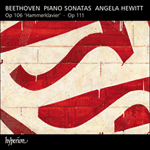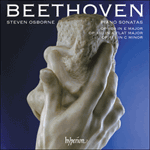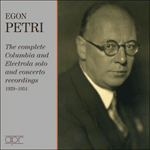
Welcome to Hyperion Records, an independent British classical label devoted to presenting high-quality recordings of music of all styles and from all periods from the twelfth century to the twenty-first.
Hyperion offers both CDs, and downloads in a number of formats. The site is also available in several languages.
Please use the dropdown buttons to set your preferred options, or use the checkbox to accept the defaults.

Beethoven also arranged for an edition to be published by Muzio Clementi in London. This was quite in order, since Clementi and Schlesinger served different markets, and the two editions appeared almost simultaneously. Beethoven initially intended to dedicate the sonata to his friend and patron Archduke Rudolph, but changed his mind at the last minute and substituted Antonie Brentano. The change was not adopted by Schlesinger, however, and his edition therefore bears a different dedication from Clementi’s.
Beethoven described these last two sonatas as ‘not very difficult’, but Op 111 in particular has numerous technical and interpretative challenges. Its first movement begins with a slow, portentous introduction, followed by a passionate allegro in the same key and mood as his Symphony No 5. The second theme, however, introduces brief respite in A flat, recalling the key and character of the previous sonata and helping to bind the three into a unified cycle.
The second movement again draws on vocal style, being entitled ‘Arietta’. It is another theme with variations, as in Op 109, but this time there is a consistent underlying pulse throughout. The theme, marked ‘molto semplice e cantabile’, has three main beats per bar, each beat subdivided into three. The first variation retains this pattern, but in the second the beat is subdivided differently, and the following variation is still more complex, with the beat subdivided into four groups of three sub-beats. This gives rise to notational peculiarities, and Beethoven’s time signature of 12/32 is not strictly correct. The notation certainly perplexed an early reviewer in The Harmonicon, who wrote: ‘But no sphinx ever imagined such a riddle as the twelve-thirty-two time presents.’ In performance, however, everything works out perfectly, and the variation possesses an extraordinary jazz-like exuberance that was far ahead of its day. It is followed by a quiet, seemingly timeless variation and finally a lengthy coda that rounds off not just this sonata, not even the set of three, but Beethoven’s whole sonata output: he never seriously contemplated writing any further sonatas.
Since the sonata contains only two movements, both Schlesingers asked Beethoven whether he had forgotten to send the finale. At face value this seemed a reasonable enquiry, for the normal sonata pattern was fast–slow–fast, rather than fast–slow, as here. But it would be impossible to imagine any effective continuation after such a profound and spiritual movement, which can be seen as a true foretaste of heaven.
from notes by Barry Cooper © 2019
Beethoven prit aussi des dispositions pour qu’une édition soit publiée par Muzio Clementi à Londres. C’était tout à fait de mise, car Clementi et Schlesinger desservaient des marchés différents, et les deux éditions parurent presque simultanément. Au départ, Beethoven avait l’intention de dédier cette sonate à son ami et protecteur l’archiduc Rodolphe, mais il changea d’avis à la dernière minute et lui substitua Antonie Brentano. Toutefois, ce changement ne fut pas adopté par Schlesinger dont l’édition porte donc une dédicace différente de celle de Clementi.
Beethoven décrivit ces deux dernières sonates comme «pas très difficiles», mais l’op.111 en particulier présente de nombreux défis en matière de technique et d’interprétation. Son premier mouvement commence par une introduction lente et solennelle, suivie d’un allegro passionné dans la même tonalité et la même atmosphère que sa cinquième symphonie. Toutefois, le second thème introduit un court répit en la bémol majeur, rappelant la tonalité et le caractère de la sonate précédente ce qui contribue à créer un lien entre les trois pour en faire un cycle unifié.
Le second mouvement intitulé «Arietta» s’inspire une fois encore du style vocal. C’est un autre thème avec variations, comme dans l’op.109, mais cette fois il y a une pulsation sous-jacente constante du début à la fin. Le thème, marqué «molto semplice e cantabile», comporte trois temps forts par mesure, chacun divisé en trois. La première variation conserve ce modèle, mais dans la deuxième le temps fort est subdivisé de manière différente, et la variation suivante est encore plus complexe, avec le temps fort subdivisé en quatre groupes de trois temps faibles, ce qui donne lieu à des singularités dans la notation, et le chiffrage des mesures de Beethoven n’est pas tout à fait correct. Cette notation plongea certainement dans la perplexité l’un des premiers critiques de The Harmonicon, qui écrivit: «Mais aucun sphinx n’a jamais imaginé une énigme comme celle que constitue une mesure à 12/32». Toutefois, à l’exécution, tout fonctionne parfaitement et cette variation possède une extraordinaire exubérance proche du jazz, très en avance sur son temps. Elle est suivie d’une variation calme, apparemment éternelle et finalement d’une assez longue coda qui conclut non seulement cette sonate, pas même l’ensemble des trois, mais toute la production de sonates de Beethoven: il n’a jamais sérieusement envisagé d’écrire d’autres sonates.
Comme cette sonate ne comporte que deux mouvements, les deux Schlesinger demandèrent à Beethoven s’il avait oublié d’envoyer le finale. En elle-même, cette question semblait fondée, car le schéma normal de la sonate était rapide–lent–rapide, plutôt que rapide–lent, comme ici. Mais il serait impossible d’imaginer une suite plausible après un mouvement aussi profond et spirituel, que l’on peut considérer comme un véritable avant-goût du paradis.
extrait des notes rédigées par Barry Cooper © 2019
Français: Marie-Stella Pâris
Beethoven sorgte außerdem dafür, dass eine weitere Ausgabe bei Muzio Clementi in London erschien. Weil Clementi und Schlesinger unterschiedliche Märkte bedienten, war das völlig angebracht; beide Ausgaben erschienen fast zur selben Zeit. Beethoven hatte die Sonate ursprünglich Erzherzog Rudolph widmen wollen, seinem Freund und Gönner; doch entschied er sich in letzter Minute anders und setzte Antonie Brentano als Widmungsträgerin ein. Schlesinger übernahm diese Änderung nicht mehr, sodass seine Ausgabe eine andere Widmung trägt als die Clementis.
Diese letzten beiden Sonaten bezeichnete Beethoven als „nicht gar schwer“; doch besonders Opus 111 stellt Technik und Interpretationsvermögen des Spielers vor zahlreiche Schwierigkeiten. Der erste Satz beginnt mit einer langsamen, gewichtigen Einleitung; ihr folgt ein leidenschaftliches Allegro, das in Tonart und Gehalt der 5. Symphonie nahesteht. Das zweite Thema bringt ein kurzes Aufatmen in As-Dur, ein Blick zurück auf Tonart und Charakter der zweiten Sonate und ein weiteres Mittel, das die drei Sonaten zu einem Zyklus verbindet.
Abermals auf den Gesangsstil nimmt der zweite Satz mit dem Titel „Arietta“ Bezug. Auch hier stehen ein Thema mit Variationen, wobei hier das Grundschlag durchgängig gleich bleibt. „Molto semplice e cantabile“ bezeichnet, enthält das Thema drei Zählzeiten pro Takt, jede wiederum in drei Schläge unterteilt. Die erste Variation behält dieses Muster bei; in der zweiten jedoch werden die Zählzeiten anders unterteilt, und die darauffolgende zeigt sich noch komplexer: Hier ist das Metrum in vier Zählzeiten zu je drei Schlägen unterteilt. So kommt es zu eigentümlichen Lösungen in der Notation, und Beethovens Taktbezeichnung mit 12/32 trifft strenggenommen nicht ganz zu. In der Zeitschrift The Harmonicon zeigte sich ein Rezensent sichtlich verwirrt: „Doch keine Sphinx erdachte je ein Rätsel, wie es der Zwölf-Zweiunddreißigstel-Takt darstellt.“ Im Vortrag allerdings wirkt alles ganz unproblematisch, und die Variation ist sogar von einem gewissen jazzigen Überschwang, der weit in die Zukunft zu blicken scheint. Ihr folgt eine stille, scheinbar völlig zeitvergessene Variation und schließlich eine ausgedehnte Coda—ein Abschluss nicht allein dieser Sonate, ja nicht einmal dieser Sonatengruppe, sondern von Beethovens gesamtem Sonatenschaffen. Nie wieder erwog er ernsthaft, weitere Sonaten zu schreiben.
Weil die Sonate nur zwei Sätze enthält, fragten Vater und Sohn Schlesinger nach, ob Beethoven vielleicht vergessen hätte, das Finale mitzuschicken. Vordergründig leuchtet das auch ein, denn die übliche Satzfolge einer Sonate war schnell–langsam–schnell und nicht, wie hier, schnell–langsam. Doch erscheint es unvorstellbar, was noch folgen könnte auf einen so tiefgründigen, vergeistigten Satz—einen Satz, den man geradezu als Vision des Paradieses erleben kann.
aus dem Begleittext von Barry Cooper © 2019
Deutsch: Friedrich Sprondel
 Beethoven: Beethoven Unbound Beethoven: Beethoven UnboundA comprehensive new cycle of the Beethoven sonatas recorded live at London's Wigmore Hall during the pianist's epic fourth rendition of these masterpieces .» More |
 Beethoven: Piano Sonatas Opp 106 & 111 Beethoven: Piano Sonatas Opp 106 & 111Two monumental masterworks prove a fitting end to a magnificent Beethoven sonata cycle.» More |
 Beethoven: Piano Sonatas Opp 109, 110 & 111 Beethoven: Piano Sonatas Opp 109, 110 & 111Beethoven’s three final sonatas together constitute one of music’s great spiritual journeys, one which only a very few pianists in any age are qualified to undertake. Steven Osborne, whose Beethoven has been widely acclaimed, need fear no comparis ...» More |
 Beethoven: The Final Sonatas Beethoven: The Final SonatasBeethoven's final three piano sonatas in consummate performances by Melvyn Tan, here making his first solo album for Signum.» More |
 Beethoven: The Last Three Piano Sonatas Beethoven: The Last Three Piano Sonatas‘Kinderman is evidently a thoughtful musician whose ideas about this great music are worth pondering’ (BBC Music Magazine) ‘A good deal to admire’ (American Record Guide)» More |
 Egon Petri - The complete Columbia and Electrola solo and concerto recordings Egon Petri - The complete Columbia and Electrola solo and concerto recordingsEgon Petri (1881-1962) studied with Busoni and was perhaps his greatest disciple. In his fusion of intellect with an astonishing virtuoso technique he echoed his master and gives us today the clearest idea of Busoni’s own legendary pianism.» More |

